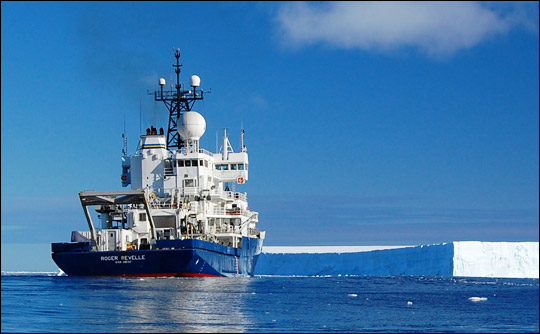

Humanity’s Unexpected ImpactThe wind measurements that Le Quéré had entered into her model held the key. Since 1981, winds in the Southern Ocean increased, and Le Quéré believes that the ozone hole and global warming are to blame. “Ozone naturally warms the upper atmosphere because it captures the radiation from the Sun and re-emits it there,” says Le Quéré. “If you deplete ozone, you get a very large cooling in the upper atmosphere.” The huge temperature difference between the ozone hole and the rest of the stratosphere causes strong winds around Antarctica. Uneven warming in different parts of the southern hemisphere from recent global warming also created a temperature difference that strengthened the winds. The stronger winds enhance deep water upwelling, which allows carbon to vent into the atmosphere from carbon-rich deep water. In essence, while the ocean may be taking up more anthropogenic carbon to keep pace with levels in the atmosphere, it’s also venting more carbon than it did in the past, and that changes the size of the overall sink. |
|||
 | |||
|
Like Feely saw in the equatorial Pacific, stronger winds made the Southern Ocean vent more carbon dioxide in areas where deep water upwelled to the surface. This idea, that upwelling water releases carbon dioxide, ran counter to what oceanographers had believed about stratification for decades. “When I started, everybody said if the ocean stratifies, then it will absorb less anthropogenic CO2. But really now, it’s not so clear,” says Le Quéré. If global warming causes upwelling areas like the high latitudes or the equatorial Pacific to stratify, then the natural carbon dioxide that is normally released during venting may just stay in the deep ocean. Stratification might wind up having competing effects on the overall carbon cycle, with saturation slowing carbon dioxide uptake in surface waters, but also suppressing venting. The other assumption that Le Quéré’s work rattled was the idea that the only way people would change the ocean carbon sink is through increased concentrations of atmospheric carbon dioxide. “At the beginning, we thought the important aspect was the increase in atmospheric CO2,” says Le Quéré. “And now, I think the changes in ocean physics [mixing] are very important as well. I wouldn’t be surprised if the changes in marine ecosystems become equally important, but we just haven’t seen this yet.” “The link between the destruction of the ozone layer, the changing wind patterns, and the impact on the carbon cycle is the thing that makes Le Quéré’s paper unique,” says Feely. “It links back to man-made impacts on the climate.” The idea that the man-made ozone hole and global warming have changed the Southern Ocean carbon sink is “disturbing on the one hand, but extremely interesting also,” says Jorge Sarmiento, an ocean modeler and Le Quéré’s former mentor at Princeton University. Not surprisingly, Le Quéré’s ground-breaking work has been controversial. Two other groups have challenged her study in letters to Science, where her work was published, but Le Quéré is standing by her results. The problem is, the method of deriving the size of the ocean sink from atmospheric carbon, not ocean carbon, is uncertain. And like all models, Le Quéré’s model has uncertainties of its own. “I think it’s possible that the Southern Ocean sink is slowing down,” says Sarmiento, “[Le Quéré] did a super job of bringing in all kinds of constraints on the model, but all of them have huge uncertainties. I’m still holding off.” Feely agrees. “In this case, modelers are leaping ahead of the observationalists. What we as oceanographers want to do is make sure that there is a sufficient amount of oceanographic data to substantiate that. You need 30 years of data before you can say anything, and that’s an incredible feat in itself.” |
The key to understanding the stability of the Southern Ocean carbon sink turned out to be winds. Since the early 1980s, winds circling Antarctica steadily increased, driven by both global warming and changes in the upper atmosphere caused by the ozone hole. (Graph by Robert Simmon, based on National Centers for Environmental Prediction (NCEP) data.) | ||
 | |||
|
And so the question remains: How is the ocean carbon sink changing? As scientists try to answer the question today, they have more tools available to them, including NASA satellites that measure the productivity of ocean plant life, winds that stir the water’s surface, and global temperature patterns that reveal ocean circulation. And in late 2008, NASA will launch the Orbiting Carbon Observatory, which will track the abundance and distribution of carbon in the atmosphere. The technology has evolved over the past decade as scientists realized that to understand the ocean carbon cycle, they are going to have to look for the human fingerprint in ocean circulation and biology, not just in ocean chemistry. “When I started about 15 years ago, it was assumed that the circulation of the ocean did not change. The only thing we ever thought about was carbon dioxide increasing in the atmosphere,” says Le Quéré. “Now we have a much broader view of what is happening. I think very few people accept the steady state hypothesis anymore. That’s finished.” |
Like much research, Feely and Le Quéré’s work creates almost as many questions as answers: What other climate cycles affect the oceanic carbon sink? Will the Southern Ocean return to normal as Antarctic ozone recovers? Will the increasing severity of global warming finally cause much of the ocean surface to stratify? In time—with continuing study—these questions will be answered, to be replaced with new ones. (Photograph ©2008 Brett Longworth.) | ||